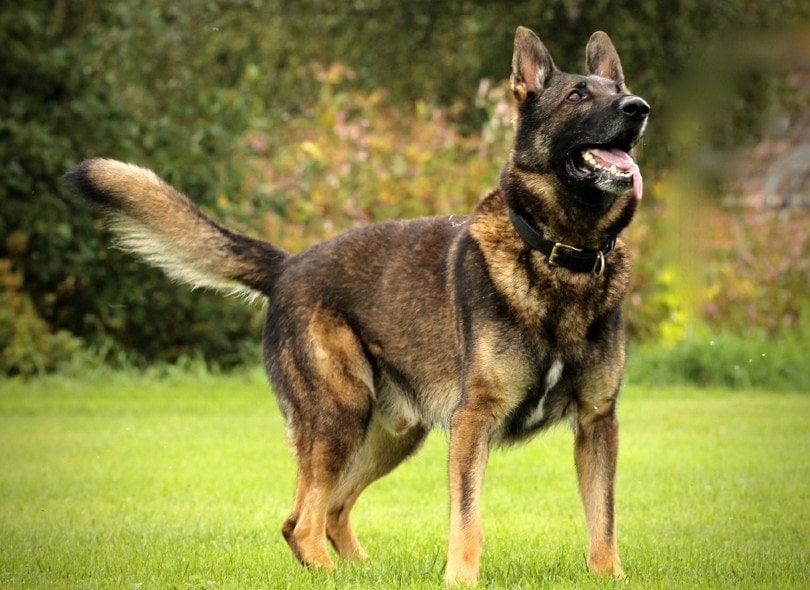The American Working Line German Shepherd is a high energy, intelligent, and trainable dog bred for performance, protection, and service work, excelling in active homes that provide proper training, exercise, and mental stimulation.
The American Working Line German Shepherd (American working line GSD) is a remarkable breed known for its loyalty, intelligence, and high working drive. Unlike show lines, these dogs are bred for performance, stamina, and reliability in demanding tasks.
Whether serving as German Shepherd protection dogs, participating in police work, or excelling in search and rescue missions, the American working line stands out as a versatile and dedicated canine partner.
In this guide, we’ll explore German Shepherd work line traits, training needs, health considerations, and how they compare to European working lines.
Origin and Background
The German Shepherd working dog lineage began in Germany in the late 19th century. While both American and European working lines share this heritage, American breeders adapted the breed for versatility, focusing on American GSD working ability in law enforcement, military service, and as loyal family protectors.
Over the decades, American working line German Shepherd puppies have been selectively bred to enhance trainability, adaptability, and endurance qualities essential for demanding jobs.
Key Traits of the American Working Line GSD

When it comes to German Shepherd work line traits, the American working line is known for:
- Trainability of American working line German Shepherd Quick learners who respond well to consistent, reward based training.
- High energy German Shepherd breed Requires plenty of exercise and mental challenges to stay balanced.
- Protective instincts in the working line GSD Naturally alert and responsive, making them excellent guardians.
- Working drive in German Shepherd dogs Strong desire to perform tasks, whether it’s obedience, tracking, or protection work.
These dogs are less focused on conformation standards and more on functional abilities.
American GSD vs European GSD
When comparing American GSD vs European GSD, there are notable differences:
| Feature | American Working Line GSD | European Working Line GSD |
| Purpose | Versatile, adaptable for family and work | Primarily specialized in police/military work |
| Appearance | Slightly taller, lighter build | Stockier, heavier bones |
| Temperament | Balanced mix of drive and calmness | Extremely high working drive |
| Training Focus | Obedience and adaptability | Intense task specific training |
While both are exceptional working dogs, the American version often suits families seeking both a capable worker and a reliable companion.
Temperament and Personality
The working line GSD temperament is marked by intelligence, loyalty, and resilience. American lines are typically:
- Adaptable Able to adjust to different environments and lifestyles (adaptability of working line GSDs).
- Focused Maintains attention on the handler during training and tasks.
- Confident Stable under pressure, whether in crowds or high stress situations.
Their temperament makes them excellent candidates for German Shepherd service dog training and as therapy dogs when properly socialized.
Training Your American Working Line German Shepherd
Training should begin early for American working line GSDs to channel their high drive productively. Important points include:
- Obedience training for American working line dogs builds discipline and prevents unwanted behaviors.
- Structured socialization reduces reactivity toward strangers and other animals.
- Advanced task training can prepare them for police and military German Shepherd lines roles.
Reward based techniques work best, as these dogs thrive when they feel engaged and purposeful.
Exercise and Activity Requirements
Because they are a high energy German Shepherd breed, these dogs need more than daily walks.
- Exercise needs for American working line GSD include agility, tracking, fetch, and obedience drills.
- Mental stimulation is just as important puzzle toys, scent work, and advanced commands prevent boredom.
Without proper activity, a working line GSD may develop destructive habits due to unspent energy.
Health and Lifespan
Working line GSD health and lifespan tend to be robust when bred responsibly. However, common concerns include:
- Hip and elbow dysplasia
- Degenerative myelopathy
- Allergies and skin sensitivities
With regular vet check ups, a balanced diet, and adequate exercise, the American working line GSD can live 10–14 years in good health.
Finding the Best Breeders
If you’re searching for best working line German Shepherd breeders, consider:
- Breeders who test for genetic health conditions.
- Puppies raised in stimulating environments for early development.
- Transparent lineage records for German Shepherd working dog lineage.
A reputable breeder ensures you’re getting a healthy pup with the right temperament for your needs.
Suitability as a Family Dog

While bred for work, the American working line GSD can also be a devoted family companion. With proper training and socialization, they:
- Bond closely with their family.
- Protect children and property.
- Participate in active family lifestyles like hiking or running.
However, they are not ideal for sedentary households, as they require consistent engagement.
Differences Between Show and Working Lines
The differences between show line and working line GSD are more than appearance:
- Show lines prioritize physical beauty for competitions.
- Working lines prioritize drive, stamina, and utility.
If you want a dog capable of intense work, the working line is the better choice.
FAQs:
1. What makes the American Working Line GSD different from the European line?
American working line GSDs are versatile and slightly calmer, balancing work ability with family suitability, while European lines often have more intense drive for specialized police or military work.
2. Are American Working Line German Shepherds good family pets?
Yes, with proper training and socialization, they are protective, loyal, and adaptable, making them great companions for active families that can meet their exercise and mental stimulation needs.
3. How much exercise does an American Working Line GSD need daily?
They require at least 90 minutes of combined physical and mental activity daily, including obedience training, agility, tracking, and interactive play, to stay healthy and prevent behavioral issues.
4. What health issues are common in American Working Line German Shepherds?
They may face hip and elbow dysplasia, degenerative myelopathy, and allergies. Responsible breeding, balanced nutrition, and regular vet care help minimize these risks and extend lifespan.
5. How can I find the best American Working Line German Shepherd breeder?
Choose breeders with health tested dogs, transparent lineage records, and early socialization practices, ensuring the puppy inherits strong working traits, stable temperament, and good overall health.
Conclusion
The American Working Line German Shepherd is a remarkable working dog that thrives in active, structured environments. Bred for intelligence, stamina, and loyalty, they excel in service, protection, and family roles. Their high energy, strong work ethic, and adaptability require committed owners who can provide consistent training, exercise, and mental engagement. Sourced from reputable breeders, these dogs become lifelong partners capable of exceptional performance and deep companionship, making them an ideal choice for those seeking a reliable and devoted canine companion.
Related Post:
- My Cat Sounds Congested When Breathing – Causes & Solutions!
- My Cat Is Limping But Acting Normal – Should You Be Worried!
- How Often Should Cats Get Rabies Shots – You Need to Know!
